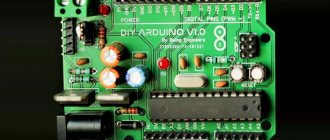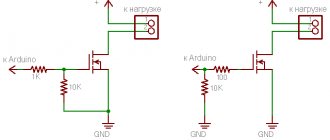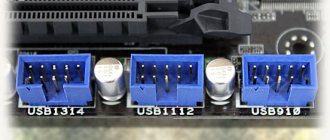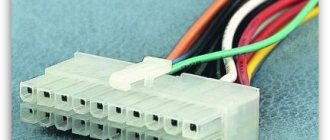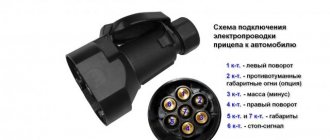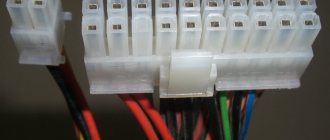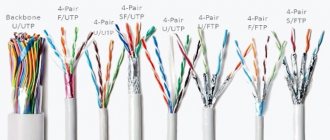Uno sizes
Arduino Uno R3 is the most popular board based on the ATmega328 processor. Depending on the specific model of the board in this line, various microcontrollers are used; at the time of writing, the most common version is R3.
The board is used for training, development, and creation of working prototypes of devices. Arduino, at its core, is an AVR microcontroller with simplified programming and development capabilities. This was achieved using a specially prepared bootloader flashed into the MK’s memory and a proprietary development environment.
Arduino Uno board
The dimensions of the board are shown in the diagram below. The overall dimensions of the Uno are 53.4 mm by 68.6 mm .
Arduino Mini board
It is one of the simplest and most convenient Arduino devices.
An ATmega 168 microcontroller with an operating voltage of 5 volts and a frequency of 16 MHz is used. The maximum supply voltage in models is 9 volts. The maximum current at the terminals is 40 mA.
The fee contains:
- 14 digital pins (6 of them can be used as PWM outputs), can be used as both input and output;
- 8 analog inputs (4 of them are equipped with pins);
- 16 MHz – crystal oscillator.
The pins of the Arduino Mini device have the following purposes:
- Two pins through which the plus board is powered: RAW, VCC.
- The minus contact output is the GND pin.
- Pins numbered 3, 5, 6, 9, 10, 11 are used for PWM when using the analog Write function.
- Other devices can be connected to pins No. 0, No. 1.
- Analog inputs No. 0 – No. 3 with outputs.
- Analog inputs No. 4 – No. 7 do not have pins and require soldering if necessary.
- AREF pin, which is designed to change the upper voltage.
- Reset output – reboot the microcontroller.
The pin layout may vary between different versions of arduino mini.
Characteristics
The board is based on the ATmega 328 processor. In addition to it, the board contains a USB module for communication with a computer and firmware. This module is called "USB-TTL converter". On branded Arduino Uno boards, an additional ATmega16U2 .
| Characteristics | Arduino Uno R3 |
| Microcontroller | ATmega328 |
| Operating voltage | 5V |
| Supply voltage (recommended) | 7-12V |
| Supply voltage (limit) | 6-20V |
| Digital inputs/outputs | 14 (of which 6 can be used as PWM outputs) |
| Analog inputs | 6 |
| Maximum current per pin | 40 mA |
| Maximum pin output current 3.3V | 50 mA |
| Flash memory | 32 KB (ATmega328) of which 0.5 KB is used by the bootloader |
| SRAM | 2 KB (ATmega328) |
| EEPROM | 1 KB (ATmega328) |
| Clock frequency | 16 MHz |
The peculiarity of this chip is its hardware support for USB, which allows communication without additional converters. While ATmega328 does not support such a function, so 16u2 acts as a data converter from USB to serial port for the AVR MK. It contains a program to perform this task.
However, this is not always the case: smaller boards, such as the Arduino Nano, use level converters based on various chips, for example FT232, CP21XX, Ch340g and the like. This solution is cheaper and does not require flashing an additional link controller as described above.
Attention ! Not everything is so simple with DCcduino UNO r3 on ch340g. It uses a cheaper version of the USB-TTL converter than the original.
The board has a 3.3 V output, it is needed to connect peripherals and some sensors, its current capacity is 50 mA.
ATmega328 operates at 16 MHz. It is fixed by a quartz resonator, which you can, if desired, replace, thereby speeding up the operation of the Uno r3.
Important! After replacing the crystal, time-related functions such as Delay will not match the entered values. This is a time delay function, by default its argument is the required delay time in ms. The function is written in the Arduino libraries, taking into account the standard clock frequency of 16 MHz. Therefore, after replacing the quartz, the specified time will not correspond to what was written. To do this, you need to either select experimentally and install dependencies, or edit library files.
Arduino Mini board
It is one of the simplest and most convenient Arduino devices.
An ATmega 168 microcontroller with an operating voltage of 5 volts and a frequency of 16 MHz is used. The maximum supply voltage in models is 9 volts. The maximum current at the terminals is 40 mA.
The fee contains:
- 14 digital pins (6 of them can be used as PWM outputs), can be used as both input and output;
- 8 analog inputs (4 of them are equipped with pins);
- 16 MHz – crystal oscillator.
The pins of the Arduino Mini device have the following purposes:
- Two pins through which the plus board is powered: RAW, VCC.
- The minus contact output is the GND pin.
- Pins numbered 3, 5, 6, 9, 10, 11 are used for PWM when using the analog Write function.
- Other devices can be connected to pins No. 0, No. 1.
- Analog inputs No. 0 – No. 3 with outputs.
- Analog inputs No. 4 – No. 7 do not have pins and require soldering if necessary.
- AREF pin, which is designed to change the upper voltage.
- Reset output – reboot the microcontroller.
The pin layout may vary between different versions of arduino mini.
Pin location, pinout
The developers of the Arduino board arranged the board pins very conveniently and logically. The fact is that when developing on “pure” AVR microcontrollers, it was necessary to refer to the port output; for this it was necessary to remember the name of each pin on the chip. It's much easier here. The name of each pin is indicated on the board itself. What adds convenience is that the pins are divided into 3 groups:
- Digital – block of digital pins.
- Analog – block of analog pins.
- Power – a block of pins that are associated with power supply and operation of the microcircuit.
Pinout of the board
In this case, in the Digital section, pins that can output a PWM signal (PWM) are marked with a tilde “ ~ ”. For service purposes and checking the functionality of the controller, an LED is installed on the board, which is connected to pin 13, and from the Arduino IDE development environment it can be accessed through the built-in directive LED_BUILTIN . Such pin layouts are called “Arduino UNO pinout”, and instead of UNO, the name of another board that interests you may be indicated.
Arduino Micro Board
Arduino Micro is a device based on the ATmega 32u4 microcontroller, which has a built-in USB controller. This solution simplifies connecting the board to a computer, since the system will recognize the device as a regular keyboard, mouse or COM port. The composition of the device is as follows:
- number of inputs/outputs – 20 (it is possible to use 7 of them as PWM outputs, and 12 as analog inputs); quartz resonator tuned to 16 MHz;
- micro-USB connector;
- ICSP connector designed for internal programming;
- reset button.
All digital pins of the product can work as both inputs and outputs thanks to the digital Read, pin Mode, digital Write functions. The voltage at the terminals is 5 volts. The maximum current consumed or supplied from one pin is 40 mA. The pins are connected to internal resistors, which are off by default. They have ratings of 20 kOhm - 50 kOhm. Separate arduino micro pins, in addition to the main ones, are capable of performing a number of additional functions:
- In the serial interface, pins No. 0 (RX), No. 1 (TX) are used to receive (RX) as well as transmit (TX) the necessary data through the built-in hardware transceiver. The function is relevant for arduino micro Serial class. In other cases, communication is via a USB connection (CDC).
- The TWI interface includes microcontroller pins No. 2 (SDA) and No. 3 (SCL). Allows you to use Wire library data.
- Pins numbered 0, 1, 2, 3 can be used as sources of interrupts. These include low signal level; interrupts on the edge, on the fall, when the signal level changes.
- Pins numbered 3, 5, 6, 9, 10, 11, 13, when using the analog Write function, are capable of outputting an 8-bit analog PWM signal.
- The SPI interface includes pins on the ICSP connector. They do not connect to digital pins on the board.
- Additional RX LED/SS pin, which is connected to the LED. The latter indicates the process of data transfer using USB. This pin can be used when working with the SPI interface for the SS pin.
- Pin No. 13 is an LED that turns on when sending HIGH data and turns off when sending LOW data.
- Pins A0 – A5 (marked on the board) and A6 – A11 (corresponding to digital pins numbered 4, 6, 8, 9, 10,12) are analog.
- The AREF pin allows you to change the upper value of the analog voltage on the above pins. This uses the analog Reference function.
- Using the Reset pin, a low level (LOW) is formed and the microcontroller is rebooted (reset button).
Description of board pins
The microcontroller has 14 digital pins , they can be used as input or output. Of these, 6 can output a PWM signal. They are needed to regulate load power and other functions.
| Arduino pin | Addressing in a sketch | Special appointment | PWM |
| Digital pin 0 | 0 | RX | |
| Digital pin 1 | 1 | TX | |
| Digital pin 2 | 2 | Interrupt input | |
| Digital pin 3 | 3 | Interrupt input | PWM |
| Digital pin 4 | 4 | ||
| Digital pin 5 | 5 | PWM | |
| Digital pin 6 | 6 | PWM | |
| Digital pin 7 | 7 | ||
| Digital pin 8 | 8 | ||
| Digital pin 9 | 9 | PWM | |
| Digital pin 10 | 10 | SPI (SS) | PWM |
| Digital pin 11 | 11 | SPI (MOSI) | PWM |
| Digital pin 12 | 12 | SPI (MISO) | |
| Digital pin 13 | 13 | SPI (SCK) A built-in LED is additionally connected to the output |
The PWM signal is called via the AnalogWrite command (pin number, value from 0 to 255 ). To work with analog sensors, there are 6 analog inputs/outputs.
| Pin | Addressing in a sketch | Special appointment |
| Analog pin A0 | A0 or 14 | |
| Analog pin A1 | A1 or 15 | |
| Analog pin A2 | A2 or 16 | |
| Analog pin A3 | A3 or 17 | |
| Analog pin A4 | A4 or 18 | I2C (SCA) |
| Analog pin A5 | A5 or 19 | I2C (SCL) |
They can also be used as digital ones.
The analog signal is processed by a 10-bit analog-to-digital converter (ADC), and when read, the microcontroller produces a numerical value from 0 to 1024 . This is equal to the maximum value that can be written in 10 bits. Each of the pins is capable of delivering a constant current of up to 40 mA.
The circuit diagram of the board looks like this (click to enlarge):
Arduino Uno board
The word Uno is translated from Italian as “one”. The device is named in connection with the beginning of the release of Arduino 1.0. In other words, Uno is the reference model for the entire Arduino-type platform. This is the latest in a series of USB boards that have proven their effectiveness and stand the test of time.
Arduino Uno is created on an ATmega 328 microcontroller (datasheet).
Its composition is as follows:
- the number of digital inputs and outputs is 14 (and six of them can be used as PWM outputs);
- the number of analog inputs is six;
- 16 MHz – quartz resonator;
- there is a power connector;
- there is a connector designed for ICSP programming inside the circuit itself;
- There is a reset button.
It is extremely important to note that a distinctive feature of all new arduino boards is the use of an ATmega 16U2 microcontroller (or ATmega 8U2 in versions R1, R2) for the USB-UART interfaces instead of the outdated FTDI type microcircuit.
The Uno board version R2 is equipped with an additional pull-up resistor on the HWB line of the microcontroller used.
The pinout looks like this:
- The serial interface uses buses No. 0 (RX – data reception), No. 1 (TX – data transmission).
- For external interruption, pins No. 2, No. 3 are used.
- For PWM, pins numbered 3.5, 6, 9, 10, 11 are used. The analog Write function provides a resolution of 8 bits.
- Communication via SPI: pins No. 10 (SS), No. 11 (MOSI), No. 12 (MISO), No. 13 (SCK).
- Pin No. 13 powers the LED, which lights up at high potential.
- Uno is equipped with 6 analog inputs (A0 – A5), which have a resolution of 10 bits.
- To change the upper voltage limit, use the AREF pin (analog Reference function).
- I2C communication (TWI, Wire library) is carried out through pins No. 4 (SDA), No. 5 (SCL).
- Reset output – reboot the microcontroller.
1.1. Arduino Uno R3 board and its pinout
The device is built on an ATmega16U2 microcontroller and has an increased level of noise immunity in the reset circuit.
The device differs from the previous version only in that in this case the USB-UART FTDI interface is not used when connecting to a computer. This task is performed by the ATmega 16U2 microcontroller itself.
The board pinout changes look like this:
- Two pins have been added near the AREF pin: SDA, SCL.
- Two pins have also been added near the RESET pin: IOREF, which allows you to connect expansion cards with adjustment to the required voltage; the second pin is not used and is in reserve.
Work in conjunction with other systems
The very first thing you can get acquainted with, even without purchasing additional development devices, is serial communication. It is activated by the Serial.begin command (speed, for example 9600 ). You can read more about each command in the training section on the official website of the project Arduino.ru. You can exchange information with the computer. The board, depending on the program code, can send you data, and you can read it through the port monitor in the Arduino IDE.
In addition to the serial port, Arduino UNO supports the following interfaces:
- I2C;
- SPI.
Through them you can communicate between several boards, as well as connect various peripherals: sensors and displays.
Expansion cards
In stores specializing in robotics and microcontrollers, you can find the word “shield”. This is a special board that resembles an Arduino Uno. It matches it not only in shape, but also in the number of pins.
The shield is installed in terminal blocks, while part of them is used for shield functions, and the other part remains free for use in the project. As a result, you can get a multi-story “sandwich” of boards that implement many functions.
One of the most popular is Arduino Ethernet Shield. It is needed to communicate with Arduino via a regular network cable, twisted pair. There is an rj45 connector on it.
With such a shield, you can control your microcontroller over the network via a web interface, as well as read parameters from sensors without leaving your computer. There are projects using such a kit in home cloud storage, with a speed limit, after all, Atmega328 is rather weak for such tasks, and single-board computers like Raspberry pi are better suited for this.
Arduino Uno board
The word Uno is translated from Italian as “one”. The device is named in connection with the beginning of the release of Arduino 1.0. In other words, Uno is the reference model for the entire Arduino-type platform. This is the latest in a series of USB boards that have proven their effectiveness and stand the test of time.
Arduino Uno is created on an ATmega 328 microcontroller (datasheet).
Its composition is as follows:
- the number of digital inputs and outputs is 14 (and six of them can be used as PWM outputs);
- the number of analog inputs is six;
- 16 MHz – quartz resonator;
- there is a power connector;
- there is a connector designed for ICSP programming inside the circuit itself;
- There is a reset button.
It is extremely important to note that a distinctive feature of all new arduino boards is the use of an ATmega 16U2 microcontroller (or ATmega 8U2 in versions R1, R2) for the USB-UART interfaces instead of the outdated FTDI type microcircuit.
The Uno board version R2 is equipped with an additional pull-up resistor on the HWB line of the microcontroller used.
The pinout looks like this:
- The serial interface uses buses No. 0 (RX – data reception), No. 1 (TX – data transmission).
- For external interruption, pins No. 2, No. 3 are used.
- For PWM, pins numbered 3.5, 6, 9, 10, 11 are used. The analog Write function provides a resolution of 8 bits.
- Communication via SPI: pins No. 10 (SS), No. 11 (MOSI), No. 12 (MISO), No. 13 (SCK).
- Pin No. 13 powers the LED, which lights up at high potential.
- Uno is equipped with 6 analog inputs (A0 – A5), which have a resolution of 10 bits.
- To change the upper voltage limit, use the AREF pin (analog Reference function).
- I2C communication (TWI, Wire library) is carried out through pins No. 4 (SDA), No. 5 (SCL).
- Reset output – reboot the microcontroller.
1.1. Arduino Uno R3 board and its pinout
The device is built on an ATmega16U2 microcontroller and has an increased level of noise immunity in the reset circuit.
The device differs from the previous version only in that in this case the USB-UART FTDI interface is not used when connecting to a computer. This task is performed by the ATmega 16U2 microcontroller itself.
The board pinout changes look like this:
- Two pins have been added near the AREF pin: SDA, SCL.
- Two pins have also been added near the RESET pin: IOREF, which allows you to connect expansion cards with adjustment to the required voltage; the second pin is not used and is in reserve.
How to overcome hardware limitations
Most common boards have similar characteristics, including:
- Uno;
- Nano;
- Pro mini;
- and the like.
But as your development skills develop in this environment, the problem of lack of power and speed of this platform arises. The first step to overcome the limitations is to use the C AVR language.
With its help, you will speed up the speed of accessing ports, PWM frequency and code size by an order of magnitude. If this is not enough for you, then you can use powerful models with a similar approach to development. An Arduino Mega2560 board is suitable for this. Even more powerful is the Due model. Otherwise, you should familiarize yourself with the varieties of single board computers and STM microcontrollers.
Arduino Uno R3 is an excellent board for most projects, which is used for studying digital electronics devices.

